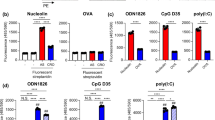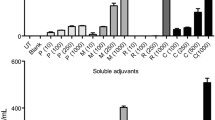Abstract
The effects of intraphagosomal toll-like receptor (TLR) activation on the MHC-restricted presentation of exogenous antigen were examined in dendritic cells (DCs). For phagosomal targeting, nanoparticles containing both a TLR agonist and a model antigen, ovalbumin (OVA), were prepared using biodegradable polymer poly(D,L-lactic acid-co-glycolic acid) and were then opsonized with mouse IgG. After incubating mouse DCs with the nanoparticles, the efficacy of OVA peptide presentation was evaluated using OVA-specific CD8 and CD4 T cells. Inclusion of either the TLR3 agonist poly(I:C) or the TLR9 agonist CpG oligodeoxynucleotides (ODN) significantly increased and prolonged both MHC class I- and class II-restricted OVA presentation. Accordingly, the DCs that phagocytosed the nanoparticles containing poly(I:C) or CpG ODN together with OVA efficiently induced the proliferation of OVA-specific CD8 and CD4 T cells. The potency levels of poly(I:C) and CpG ODN in increasing the MHC-restricted presentation of the exogenous antigen appeared to be similar. A combination of the 2 TLR agonists was synergistic in increasing the MHC class I-restricted, but not the class II-restricted, presentation of exogenous antigen. These results show that IgG-opsonized biodegradable nanoparticles containing both intraphagosomal TLR agonists and antigens can be efficient carrier materials in inducing antigen-specific T cell responses.
Similar content being viewed by others
References
Diwan, M., Elamanchili, P., Cao, M., and Samuel, J., Dose sparing of CpG oligodeoxynucleotide vaccine adjuvants by nanoparticle delivery. Curr. Drug Deliv., 1, 405–412 (2004).
Elamanchili, P., Diwan, M., Cao, M., and Samuel, J., Characterization of poly(D,L-lactic-co-glycolic acid) based nanoparticulate system for enhanced delivery of antigens to dendritic cells. Vaccine, 22, 2406–2412 (2004).
Guermonprez, P., Valladeau, J., Zitvogel, L., Thery, C., and Amigorena, S., Antigen presentation and T cell stimulation by dendritic cells. Annu. Rev. Immunol., 20, 621–667 (2002).
Harding, C. V., Collins, D. S., Kanagawa, O., and Unanue, E. R., Liposome-encapsulated antigens engender lysosomal processing for class II MHC presentation and cytosolic processing for class I presentation. J. Immunol., 147, 2860–2863 (1991).
He, H., Genovese, K. J., Nisbet, D. J., and Kogut, M. H., Synergy of CpG oligodeoxynucleotide and double-stranded RNA (poly I:C) on nitric oxide induction in chicken peripheral blood monocytes. Mol. Immunol., 44, 3234–3242 (2007).
Hirota, K., Hasegawa, T., Hinata, H., Ito, F., Inagawa, H., Kochi, C., Soma, G., Makino, K., and Terada, H., Optimum conditions for efficient phagocytosis of rifampicin-loaded PLGA microspheres by alveolar macrophages. J. Control. Release, 119, 69–76 (2007).
Huang, A. Y., Golumbek, P., Ahmadzadeh, M., Jaffee, E., Pardoll, D., and Levitsky, H., Role of bone marrow-derived cells in presenting MHC class I-restricted tumor antigens. Science, 264, 961–965 (1994).
Jakob, T., Walker, P. S., Krieg, A. M., Udey, M. C., and Vogel, J. C., Activation of cutaneous dendritic cells by CpGcontaining oligodeoxynucleotides: a role for dendritic cells in the augmentation of Th1 responses by immunostimulatory DNA. J. Immunol., 161, 3042–3049 (1998).
Kanzler, H., Barrat, F. J., Hessel, E. M., and Coffman, R. L., Therapeutic targeting of innate immunity with Toll-like receptor agonists and antagonists. Nat. Med., 13, 552–559 (2007).
Karttunen, J., Sanderson, S., and Shastri, N., Detection of rare antigen-presenting cells by the lacZ T-cell activation assay suggests an expression cloning strategy for T-cell antigens. Proc. Natl. Acad. Sci. U.S.A., 89, 6020–6024 (1992).
Kocbek, P., Obermajer, N., Cegnar, M., Kos, J., and Kristl, J., Targeting cancer cells using PLGA nanoparticles surface modified with monoclonal antibody. J. Control. Release, 120, 18–26 (2007).
Krieg, A. M., CpG motifs in bacterial DNA and their immune effects. Annu. Rev. Immunol., 20, 709–760 (2002).
Kumar, H., Kawai, T., and Akira, S., Toll-like receptors and innate immunity. Biochem. Biophys. Res. Commun., 388, 621–625 (2009).
Lee, Y. R., Yang, I. H., Lee, Y. H., Im, S. A., Song, S., Li, H., Han, K., Kim, K., Eo, S. K., and Lee, C. K., Cyclosporin A and tacrolimus, but not rapamycin, inhibit MHC-restricted antigen presentation pathways in dendritic cells. Blood, 105, 3951–3955 (2005).
Lipford, G. B., Sparwasser, T., Bauer, M., Zimmermann, S., Koch, E. S., Heeg, K., and Wagner, H., Immunostimulatory DNA: sequence-dependent production of potentially harmful or useful cytokines. Eur. J. Immunol., 27, 3420–3426 (1997).
Newman, K. D., Sosnowski, D. L., Kwon, G. S., and Samuel, J., Delivery of MUC1 mucin peptide by Poly(d,l-lactic-coglycolic acid) microspheres induces type 1 T helper immune responses. J. Pharm. Sci., 87, 1421–1427 (1998).
Newman, K. D., Elamanchili, P., Kwon, G. S., and Samuel, J., Uptake of poly(D,L-lactic-co-glycolic acid) microspheres by antigen-presenting cells in vivo. J. Biomed. Mater. Res., 60, 480–486 (2002).
Panyam, J. and Labhasetwar, V., Biodegradable nanoparticles for drug and gene delivery to cells and tissue. Adv. Drug Deliv. Rev., 55, 329–347 (2003).
Pfeifer, J. D., Wick, M. J., Roberts, R. L., Findlay, K., Normark, S. J., and Harding, C. V., Phagocytic processing of bacterial antigens for class I MHC presentation to T cells. Nature, 361, 359–362 (1993).
Sahoo, S. K., Panyam, J., Prabha, S., and Labhasetwar, V., Residual polyvinyl alcohol associated with poly (D,Llactide-co-glycolide) nanoparticles affects their physical properties and cellular uptake. J. Control. Release, 82, 105–114 (2002).
Sellins, K., Fradkin, L., Liggitt, D., and Dow, S., Type I interferons potently suppress gene expression following gene delivery using liposome(-)DNA complexes. Mol. Ther., 12, 451–459 (2005).
Shen, H., Ackerman, A. L., Cody, V., Giodini, A., Hinson, E. R., Cresswell, P., Edelson, R. L., Saltzman, W. M., and Hanlon, D. J., Enhanced and prolonged cross-presentation following endosomal escape of exogenous antigens encapsulated in biodegradable nanoparticles. Immunology, 117, 78–88 (2006).
Sigal, L. J., Crotty, S., Andino, R., and Rock, K. L., Cytotoxic T-cell immunity to virus-infected non-haematopoietic cells requires presentation of exogenous antigen. Nature, 398, 77–80 (1999).
Sigal, L. J. and Rock, K. L., Bone marrow-derived antigenpresenting cells are required for the generation of cytotoxic T lymphocyte responses to viruses and use transporter associated with antigen presentation (TAP)-dependent and -independent pathways of antigen presentation. J. Exp. Med., 192, 1143–1150 (2000).
Sparwasser, T., Koch, E. S., Vabulas, R. M., Heeg, K., Lipford, G. B., Ellwart, J. W., and Wagner, H., Bacterial DNA and immunostimulatory CpG oligonucleotides trigger maturation and activation of murine dendritic cells, Eur. J. Immunol., 28, 2045–2054 (1998).
Sparwasser, T., Vabulas, R. M., Villmow, B., Lipford, G. B., and Wagner, H., Bacterial CpG-DNA activates dendritic cells in vivo: T helper cell-independent cytotoxic T cell responses to soluble proteins. Eur. J. Immunol., 30, 3591–3597 (2000).
Stacey, K. J., Sester, D. P., Sweet, M. J., and Hume, D. A., Macrophage activation by immunostimulatory DNA. Curr. Top. Microbiol. Immunol., 247, 41–58 (2000).
Tabata, Y. and Ikada, Y., Phagocytosis of polymer microspheres by macrophages. Adv. Polym. Sci., 94, 107–141 (1990).
Takeda, K., Kaisho, T., and Akira, S., Toll-like receptors, Annu. Rev. Immunol., 21, 335–376 (2003).
Venkataprasad, N., Coombes, A. G., Singh, M., Rohde, M., Wilkinson, K., Hudecz, F., Davis, S. S., and Vordermeier, H. M., Induction of cellular immunity to a mycobacterial antigen adsorbed on lamellar particles of lactide polymers. Vaccine, 17, 1814–1819 (1999).
Weck, M. M., Grunebach, F., Werth, D., Sinzger, C., Bringmann, A., and Brossart, P., TLR ligands differentially affect uptake and presentation of cellular antigens. Blood, 109, 3890–3894 (2007).
Weiner, G. J., The immunobiology and clinical potential of immunostimulatory CpG oligodeoxynucleotides. J. Leukoc. Biol., 68, 455–463 (2000).
Whitmore, M. M., DeVeer, M. J., Edling, A., Oates, R. K., Simons, B., Lindner, D., and Williams, B. R., Synergistic activation of innate immunity by double-stranded RNA and CpG DNA promotes enhanced antitumor activity. Cancer Res., 64, 5850–5860 (2004).
Zaks, K., Jordan, M., Guth, A., Sellins, K., Kedl, R., Izzo, A., Bosio, C., and Dow, S., Efficient immunization and crosspriming by vaccine adjuvants containing TLR3 or TLR9 agonists complexed to cationic liposomes. J. Immunol., 176, 7335–7345 (2006).
Author information
Authors and Affiliations
Corresponding author
Rights and permissions
About this article
Cite this article
Lee, YR., Lee, YH., Im, SA. et al. Biodegradable nanoparticles containing TLR3 or TLR9 agonists together with antigen enhance MHC-restricted presentation of the antigen. Arch. Pharm. Res. 33, 1859–1866 (2010). https://doi.org/10.1007/s12272-010-1119-z
Received:
Accepted:
Published:
Issue Date:
DOI: https://doi.org/10.1007/s12272-010-1119-z




